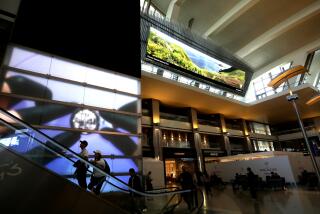JOHN WAYNE AIRPORT : Big, Small Planes Seek Airtight Solution
- Share via
A small, two-seat Cessna 152 maintained a cautious distance behind an imposing Boeing 757 as both planes waited to take off recently at John Wayne Airport.
Lurking behind the Cessna was another commercial airliner, followed by a four-engine British Aerospace jetliner. Nearby, a tiny Piper and a sleek-looking Gulfstream business jet also were lined up on the taxiway.
Bright landing lights from another commercial airliner could be seen approaching through the mid-morning haze, while small, private planes circled around, accomplishing “touch and goes” on a shorter, parallel runway. The difference in landing speeds between the airliner and the smaller planes was noticeable, maybe as great as 100 m.p.h.
Such is the frenetic pace at John Wayne Airport.
With 530,000 operations a year, it is the fifth busiest airport in the United States in takeoffs and landings. Those topping John Wayne--Chicago O’Hare, Atlanta, Los Angeles and Dallas/Ft. Worth--handle commercial airline flights almost exclusively and provide minimum services for smaller, general-aviation planes.
But about 80% of the 1,200 to 2,000 daily takeoffs and landings at John Wayne are general aviation, everything from the small Cessna 152 to a big, sleek Gulfstream jet. Pilots flying into the busy airport range from four-stripe commercial airline captains to student pilots.
Michael C. Church, owner of Sunrise Aviation at the airport and an officer of the Orange County Airport Assn., called John Wayne the “largest mixed-use” airport of its kind in the world.
Big commercial and small private planes sharing the same turf have always raised a number of safety concerns. With the $310-million airport expansion project almost complete and the number of commercial passengers increasing, concerns have intensified.
But both airport critics and boosters agree that general aviation will stay at John Wayne because of politically influential private pilots’ groups and the support of airport management, the Orange County Airport Commission and the Board of Supervisors.
“There is no written policy on the matter,” said Christine Edwards, chief of airport operations and facilities and a private pilot herself. “But the unwritten policy is that the county has always planned to keep the current level of general aviation services at John Wayne.”
There have been increased efforts lately toward peaceful coexistence.
Reports of near collisions in the air have declined at John Wayne, since January when the Federal Aviation Administration created a new safety zone, said Bob Nietzel, an FAA quality assurance specialist. At certain altitudes within that zone, general aviation pilots must be in radio contact with air traffic controllers.
“Now we know where everyone is,” Nietzel said. “It’s safer.”
Many of the general aviation facilities moved across the field to the airport’s west side with the construction of the Thomas F. Riley Terminal, creating an aircraft ground traffic pattern some pilots said causes dangerous “crisscrossing.”
“It’s just a bad physical layout and the new terminal locks this in for many years,” said Bob McGowan, a veteran pilot for a large airline, who lives in Villa Park. “It’s just a little postage stamp airport much like Midway in Chicago.”
Planes landing on the smaller, general aviation runway cross the larger runway used by commercial airliners to refuel or tie down their planes.
“I would say (crossing runways) is no worse than any other airport with parallel runways,” said airport operations chief Edwards. “The ideal situation would have been for us to flip-flop the runways or build the terminal on the other side of the airport, but we didn’t have enough land to accomplish it.”
A new taxiway scheduled to open Sept. 16 “will separate the larger and smaller planes taxiing or waiting to take off,” said Joe B. Fowler, air traffic manager at the John Wayne control tower. “The smaller planes will not have to wait behind the larger ones, avoiding concerns from pilots of smaller planes about the ‘wash’ (exhaust) from the bigger jets.”
Fowler said the new taxiway should also shorten the wait for departing airplanes.
Many aviators predict that the number of smaller planes using John Wayne will decrease as the number of commercial flights increases. The exodus, they say, will be prompted by increased costs as well as a desire by some pilots to avoid heavy traffic and sharing space with big commercial jetliners.
For the first time in recent history, the demand for outdoor general aircraft parking slots at John Wayne has slackened. The waiting list, Edwards said, was once five years. But recent policy changes and increases in airport rent--from $40 to $100 a month--have discouraged some private aircraft owners.
The safety zone has complicated flying in and out of John Wayne, among the Southland’s largest general aviation facilities. Such regulations drive private pilots to airports with fewer restrictions, said Aircraft Owners and Pilots Assn. representative Rol Murrow. Other pilots, he said, “move out because they find the atmosphere at John Wayne less friendly.”
There is only one other non-military airport in Orange County, the busy Fullerton airport, and few airfields outside the county for private pilots to use.
A few general-aviation organizations--including the AOPA--emphasize that 94% of all general aviation is for training or transferring pilots and passengers from one point to another for business purposes.
“There are very few joy riders out there any more,” said the AOPA’s Patricia Weil.
“I believe John Wayne was a good general-aviation airport,” said private pilot and retired commercial airline captain Richard D. Russell of Los Angeles, “and should have stayed that way.”
ORANGE COUNTY’S CROWDED AIRSPACE
John Wayne Airport is the fifth busiest airport in the U.S. in terms of takeoffs and landings. The ratio of private planes to commerrcial planes is about 4 to 1.
1. Jetliners have two main approaches. Jetliners from norty and south turn and cross the coast near Huntington Beach Pier and descend toward Santa Ana/Tustin. Airlines from east cross into the county over Santa Ana Canyon. Altitude: 5,000 ft.
2. Planes from both approaches then turn at the same point to become parallel with Costa Mesa (55) Freeway. Altitude: 4,000 ft.
3. Final descent to John Wayne parallels Costa Mesa (55) Freeway. Light planes occasionally cross glide path in front of jetliners. Altitude: 2,000 ft.
Small general aviation planes are allowed to fly over most of Orange County, but at certain locations they are confined to specific altitudes. For example, small planes are supposed to stay below 2,000 feet or above 4,400 feet over the city of Orange to avoid airliners in the same area that are descending toward John Wayne Airport. Also, new regulations require private pilots to be in radio contact with air traffic controllers within a 5-mile radius of the airport.
Research by Jeffrey A. Perlman/Los Angeles Times
More to Read
Sign up for Essential California
The most important California stories and recommendations in your inbox every morning.
You may occasionally receive promotional content from the Los Angeles Times.













